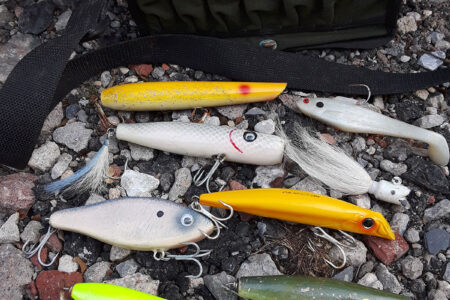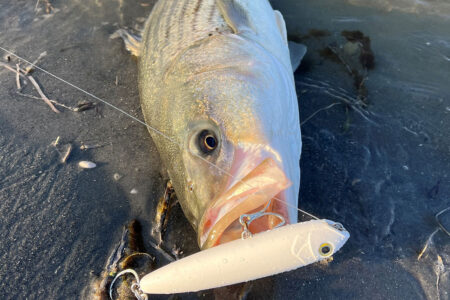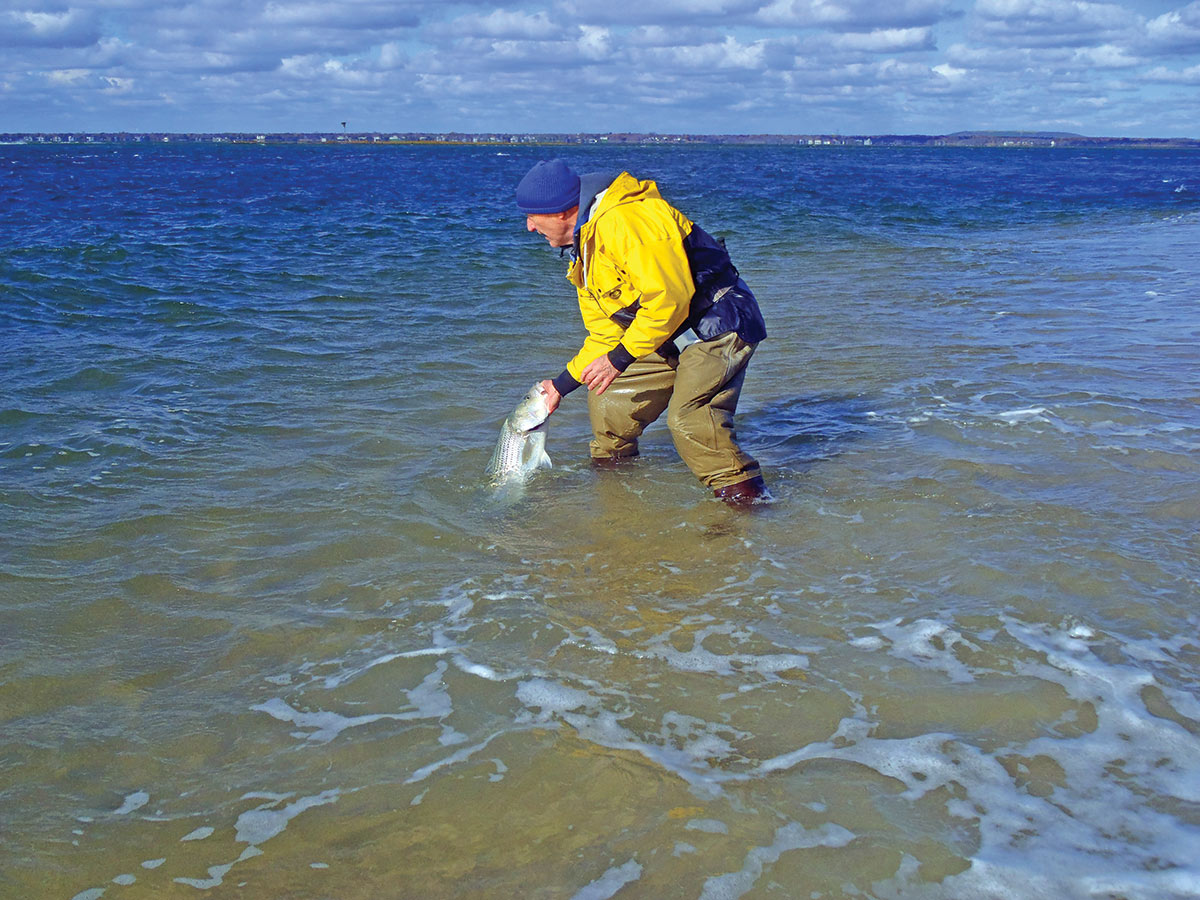
Although tides are a key in all fishing saltwater venues, in some spots and in some seasons, tides are either less significant or more. Take the fall ocean surf runs of fish for instance. Tides along the ocean are simple rises and falls of water, and there are no tide driven currents. Yes, wind and waves produce currents but they are not driven by tides. Therefore, when fish run the ocean beaches, tidal stages typically mean little. For example, the 2017 fall run of small stripers wasn’t dependent on tide and since the beaches weren’t flat as they have been in 2018, anglers could reach beyond the lip at high tide, low tide, and any time in between. In 2017 my trips were not governed by tidal stages, rather by the desire to go.
Inlets
Inlets are different. The South Shore bays are fed by the ocean but the water must rush through a narrow opening and then spread out and fill the large bays creating fast turbulent currents. However, there’s a hitch to the tidal flow in the inlets that doesn’t apply to the ocean or Long Island Sound. That is, inlets offer a challenge to an angler to understand the difference between the stated tide and the beginning of the current. The difference is a result of both distance between back-bay and ocean, and the irregular topography of the inlet and bay shoreline that includes bars and islands that retard flow and redirect it. The result is a delay between high or low water and the beginning of the current.
However, the resistance to water flow differs from one inlet and bay complex to another, therefore so too the gap between the tide and the current. So, let’s look at two examples to help us understand the delay. The bays behind Jones Inlet are less complex than some others, and the inlet defined by simpler contours. Thus, resistance to tidal flow is less. Here, the difference between high tide and the start of the outgoing current is, on average, an hour and a half. Fire Island Inlet and the bay complex behind it features more complex topography and more frictional resistance to the flow of water. Thus, the typical difference between high tide and the start of the current averages twoandahalf hours, but can be longer (more about that later).
L.I. Sound
Long Island Sound is quite different from both the ocean and the inlets. Instead of simple rises and falls, these tides are actual flows of water rushing to the west on the incoming tide and to the east on the outgoing tide. How much water flows depends upon tidal ranges, or the difference between high and low water levels, which in turn is related to moon phases. Unlike the ocean with ranges of only a few feet, the Sound can range as much as 10 feet on the moons.
So, although I don’t key my ocean trips to tide stages or ranges, I’m very careful and precise about my trips to the inlets and Long Island Sound. In general, I fish the last three hours of the ebb from the beach or in a boat in the harbors, but simply focus on moving water in a boat when fishing in deeper water in Long Island Sound. The shallower the water, the greater the impact of tide stage and tidal range on fishing. Look at it this way. If I’m fishing in a boat in 35 feet of water, can the fish “feel” a difference in tide effect between high tide at 35 feet and low tide at 28 feet? I think not. However, in a harbor where high tide depth is 8 feet and low tide depth is a foot, I think we can appreciate how bait and fish have to move with the tide. Heck, some spots covered with water at high tide may be mud flats at low tide.
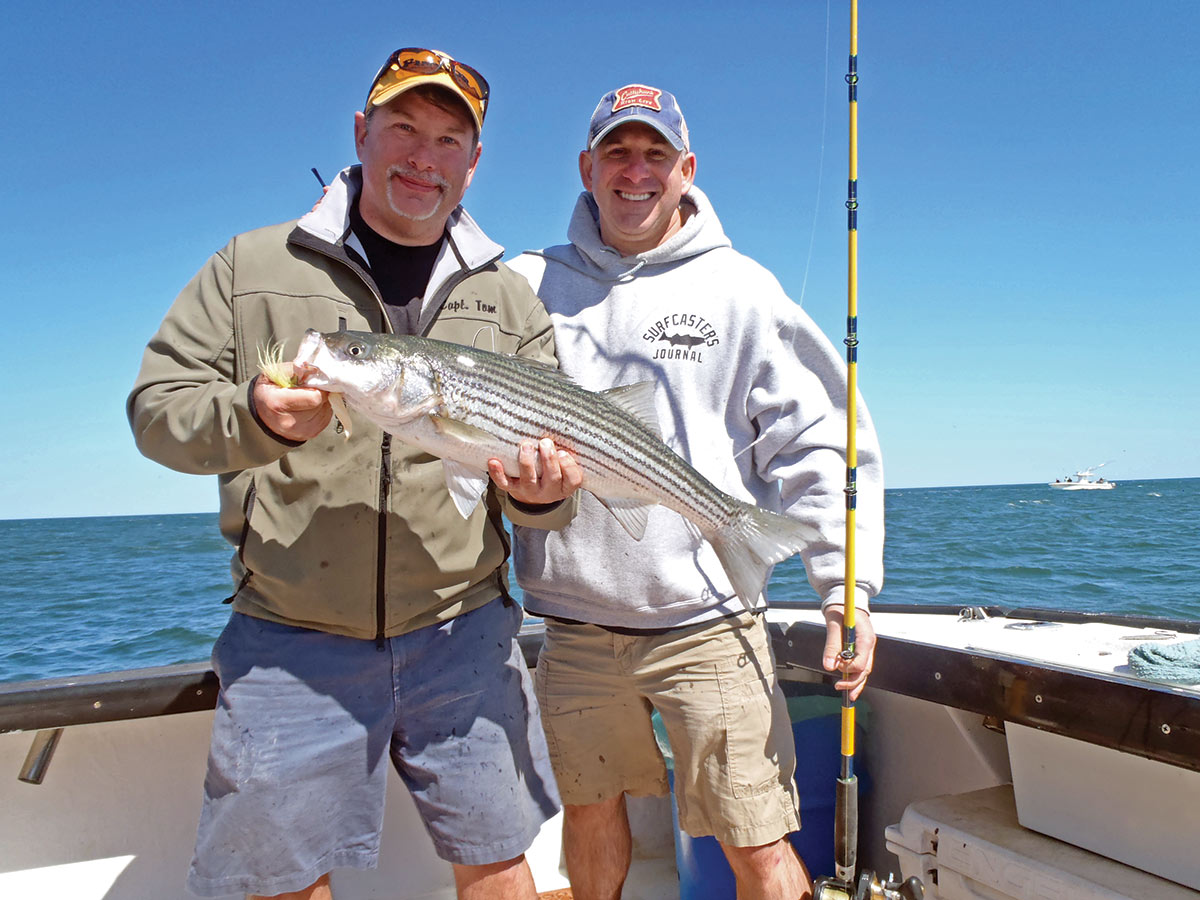
The Moon’s Effects
Tidal ranges are not uniform through the lunar cycles. Ranges are greatest around the full and new moons and least between these moon phases. In the ocean, either fishing by boat or from shore this means very little because ranges are small, but boat fishermen in the bays will have current to deal with. In addition, spots such as large bottom humps in the Sound or the rips around Montauk will also be affected by differences in tidal ranges related to moon phase. Montauk striper fishermen in boats may love the big tides because they draw stripers into the rips, but bottom fishermen may find it slows their bite. It’s a matter of one’s point of view.
Wind Effects
How strong is strong? This is an important question when it comes to how winds affect fishing. Obviously speeds of 30 mph or greater basically shut down fishing in most venues most of the times. What about 20 mph? A lot depends on the direction of the wind as well as the associated moon phase. I will and I have fished the south shore beaches in gale force winds when wind was either directly behind or angled over my back, but I’m often thwarted by a muddy surf and sand blasting when I do.
My typical benchmark for wind velocity is 17 mph; especially in the south shore bays, inlets, and in Long Island Sound. This velocity can have some positive effects especially during new and full moon periods without creating dirty water. Of course, there is a caveat. In spring, when the seaweeds are at peak abundance, even a moderate on-shore wind fills the shallows with weed regardless of whether you fish in a boat or on the shore.
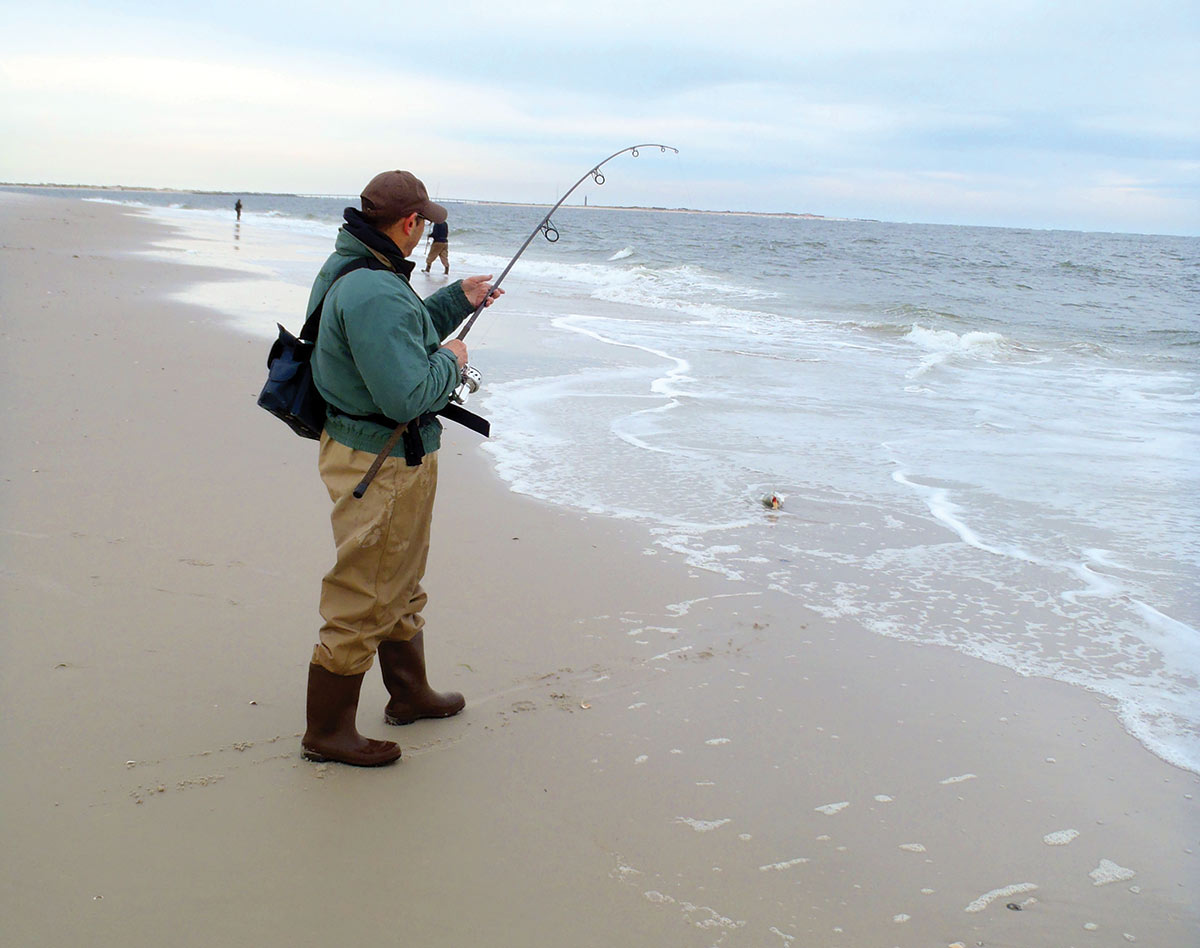
Strong winds are generally the bane of boat fishermen, but some in the surf crowd may love or hate strong winds depending upon the direction. For example, a strong west or east wind on ocean beaches can produce a nightmare of flying sand, sweeps, and bows in the line. On the other hand, west winds push water down the Sound and out to sea expanding a normal tidal range into an enormous one. If you can find a place with clean water you could find a bonanza as bait is pulled away from the shallows and into prime predator feeding areas. Several decades ago I found a point of land in Long Island Sound where the water was clean in spite of 40 mph west winds during a new moon period. It wasn’t easy to cast, retrieve, or set a hook, but since I understood the potential, I kept at it. Although exhausted by the end of the tide I caught a quite a few big fish. At low tide the fish took a rest and so did I. I looked around and couldn’t believe what I saw. There were boulders and land I’d never seen before because the moon and wind conspired to push incredible amounts of water out of L.I. Sound. It was the largest tidal range I have ever seen: I believe is was greater than 12 feet!
However, there’s always the other side of the coin. An east wind accentuates the incoming tide and raises water levels way above expected high water predictions, while at the same time increasing the time between high water and the outgoing flow. Finally, east winds hold back water on the ebb so that low tide is much higher than predicted.
The effect of east winds is similar along the South Shore. Strong east winds push water to the west, bloating New York Bight creating higher high tides, raising levels in the inlets and bays. I’ve also noted that a strong southwest wind has an effect at the inlets. So, since a strong southwest wind pushes water into the bays high tide levels will be above normal. One night on a full moon I fished Fire Island Inlet. I arrived twoandahalf hours after high tide as was my usual approach, believing I’d have decent current within 15 minutes, but that didn’t happen. A 30-mph southwest wind kept the water moving in slowly and prevented the current change. After three and a half hours I gave up and went home. Although strong winds keep me out of the boat, they do not always stop me from fishing from shore. An east wind from a storm will keep me home in Long Island Sound, but perhaps I’ll try a South Shore inlet or even the ocean.
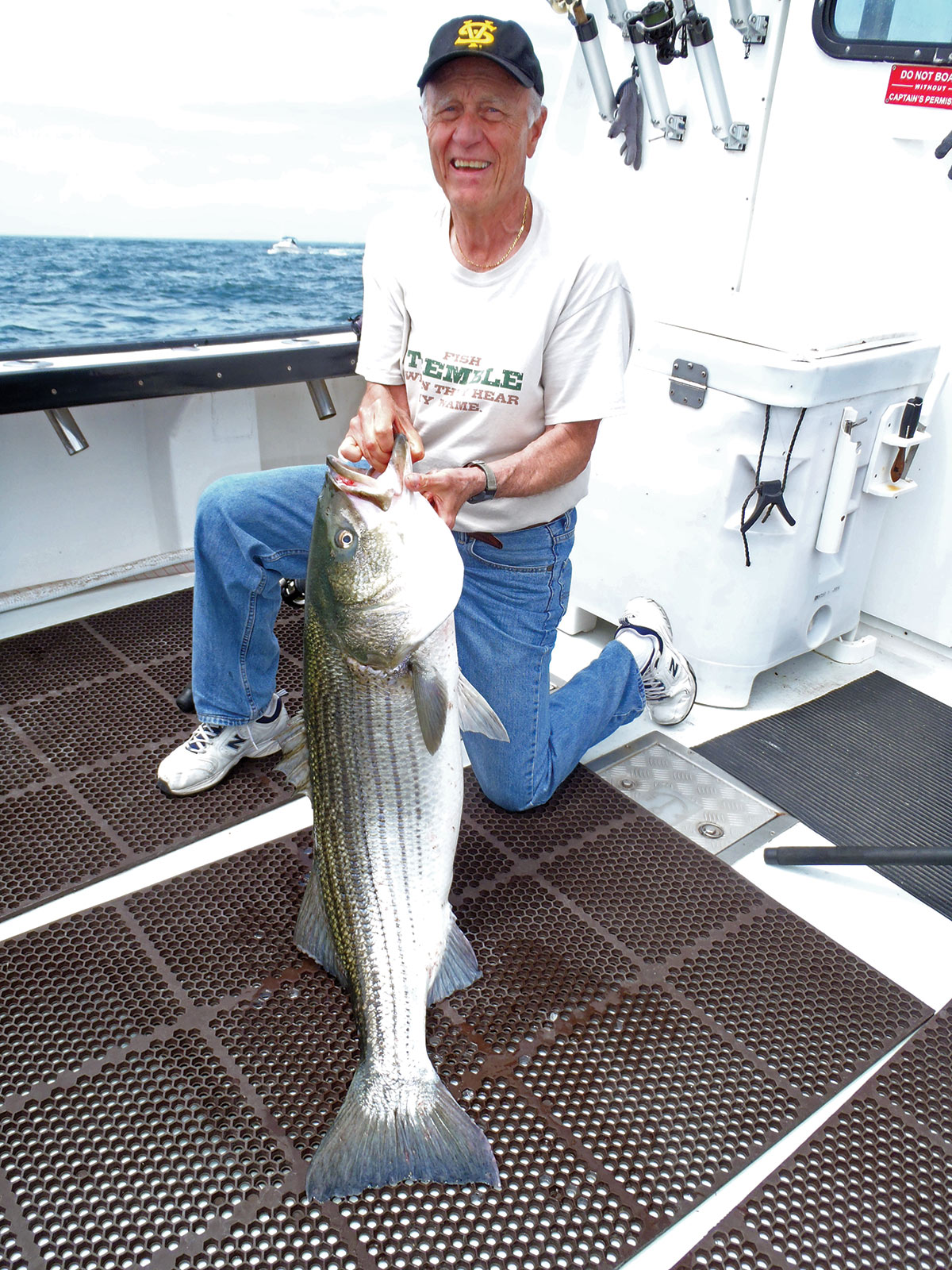
Barometric Pressure
Barometric pressure also has an effect on tides. West winds are almost always the result of high-pressure systems, while east winds are typically associated with low pressure or storm systems. A big mound of air (high-pressure system) pushes down on the water preventing very high tides, but lowering low tide levels. Contrarily, a shallow air mass in the atmosphere (low-pressure system) with less weight allows the water to rise above normal high and low tides. Obviously, this effect is enhanced with an east wind. Yet, once a high-pressure system day rolls over New England and into the north Atlantic, the winds will turn to the east. Since, we are still under the downward pressure of high pressure, high tides may not be as high and low a little lower, cancelling the east wind effect.
How I Fish
I’ve explained how several factors affect the tides, and therefore also fishing. I’ve included a few examples of how these effects have at times thwarted my success or enhanced it. As I said earlier, there are no hard rules about this and no secret formulas, rather an opportunity to use information and knowledge to plan trips whether you’re a boat or beach angler. “Nothing is either good or bad, thinking makes it so.” This adage when applied to fishing simply means that strong moon tides can be a boon or a bane depending on how and where you fish. What’s good for the surf may be deadly for bottom fishing, etc. You can see why I study moon phases, wind speeds and direction, barometric pressure, and tidal ranges, and if why is a mystery, let me explain: I like to catch fish!
Moon phase info is easy to find. It’s in magazines, newspapers, and on most calendars. Wind speed and direction is also available from many sources as is barometric pressure via T.V. forecasts, computer weather sources, and even smart phone apps. That leaves tidal ranges. Most outlets provide high tide info, but not ranges. Data on ranges throughout a month, is available on www.saltwatertides.com for many areas on Long Island. The numbers are based on mean high water and mean low water. So, a -0.5 means that low tide on that day is expected to be one-half foot below mean low water. Now, I look at the other factors and try to estimate what the actual low tide value will be: lower or higher, and plan my trip or even cancel it. I sure hope this gives you some insight into how to improve your odds of catching fish, but if all this gives you a headache, then just have fun and go fishing!


